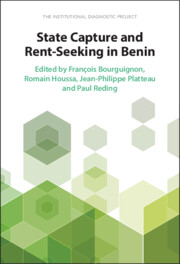Tables
1.1Cross-country comparison of interpersonal trust: 2011–2013 Round (per cent)
1.2Cross-country comparison of trust in institutions: 2011–2013 Round (per cent)
1.3Cross-country comparison of trust in institutions: Distribution of the population by ethnic group and growth rates, 2002–2013
2.1Sector-based structure of GDP (per cent of value-added at current factor prices) and informality ratios
2.2Structural changes in the Beninese economy and decomposition of changes in labour productivity, 2006–2015
2.3aBenin’s domestic and external accounts, 2002–2019 (per cent of GDP): Government revenue, expenditures, financial balance, and debt
2.3bBenin’s domestic and external accounts, 2002–2019 (per cent of GDP): Financing flows of the economy and external debt
3.3aSelected examples of detailed institutional performance: weaknesses
3.3bSelected examples of detailed institutional performance: strengths
3.4Top issues with significant differences between men and women
4.1Balance table, list experiment on politicians’ affiliation with firms
4.2List experiment: Politicians’ affiliation with local and national business interests
4.4Electoral competition (uncertainty) and firms’ strategies (capture) in local elections in Benin
4.5Effect of electoral competition (winning margin) on firms’ preference for direct capture, beta coefficients
4.6Effect of electoral reform (uncertainty decrease) on firms’ strategic decision-making, beta coefficients
4.7Effect of electoral reform (uncertainty decrease) on use of non-programmatic politics and transfers to business interests, beta coefficients
5.1Overview of mode of organisationof cotton across political regimes in Benin, 1960–present
6.3Three-stage estimates of the tax effort in sub-Saharan African countries
6.7Correlation between civil service wage bill and tax effort
8.1Nigeria’s import barriers on selected products, import tax rates (per cent) and import bans, 1995–2018
8.2Value of Benin’s imports by customs regime (per cent of GDP), 2002–2017
8.3Entrepôt trade tax rates and revenues in Togo and Benin, 2008–2017
9.1A synthetic ordering of the institutional factors impeding Benin’s long-term development



